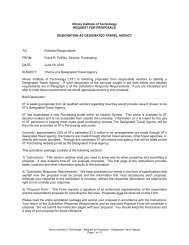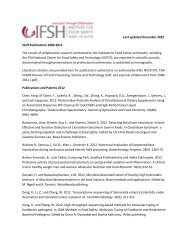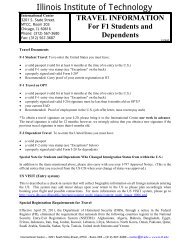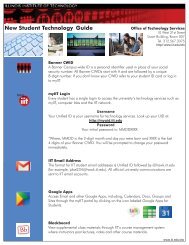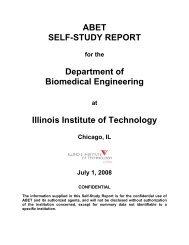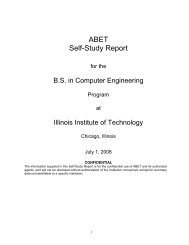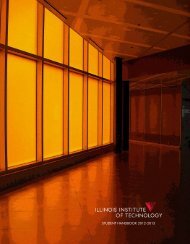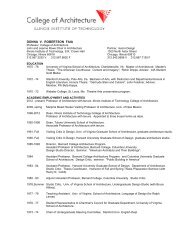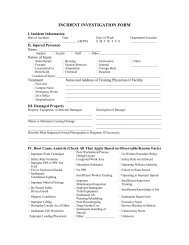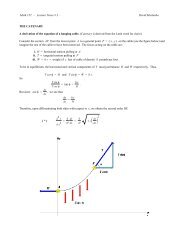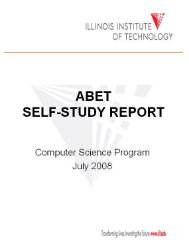Undergraduate Bulletin - Illinois Institute of Technology
Undergraduate Bulletin - Illinois Institute of Technology
Undergraduate Bulletin - Illinois Institute of Technology
Create successful ePaper yourself
Turn your PDF publications into a flip-book with our unique Google optimized e-Paper software.
Course Descriptions<br />
EG 429<br />
Computer Graphics for Desktop Publishing<br />
Integration <strong>of</strong> computer graphic-generated images into technical<br />
and business reports produced with popular desktop<br />
publishing s<strong>of</strong>tware. Emphasis on creation and selection <strong>of</strong><br />
graphical presentations for optimum readability. Scanning<br />
and retouching techniques for two- and three-dimensional<br />
presentations. Introduction to multi-media and slide presentations.<br />
Credit for this course is not applicable to an<br />
engineering degree. Junior standing required. Requires junior<br />
standing.<br />
Prerequisite(s): [(EG 329)]<br />
(2-2-3)<br />
EG 430<br />
Introduction to Building Information Modeling<br />
Fundamentals and practical use <strong>of</strong> information technologies<br />
in design; basic concepts <strong>of</strong> building information modeling<br />
(BIM); review <strong>of</strong> s<strong>of</strong>tware and technology available for BIM;<br />
practical use <strong>of</strong> BIM in design for creating a site, viewing a<br />
model, starting a project, working in the AutoDesk “Revit”<br />
Environment, adding basic building elements to a project,<br />
conceptual energy analysis, designing a preliminary layout,<br />
and presenting a project. Requires senior standing.<br />
(3-0-3)<br />
EG 497<br />
Special Problems<br />
Special problems. Requires junior standing. Requires junior<br />
standing.<br />
(Credit: Variable)<br />
Engineering Management<br />
EMGT 363<br />
Creativity, Inventions, & Entrepreneurship for Engineers &<br />
Scientists<br />
This course will introduce students to theories, processes, and<br />
best practices that invoke creativity, innovation, inventions,<br />
and entrepreneurship in engineers and scientists to create a<br />
patentable technology by the end <strong>of</strong> the semester. Skills will<br />
be developed in understanding and searching for patents,<br />
learning and applying brainstorming, team learning, exploring<br />
deep needs, market and industry analysis, finding “white<br />
space,” and creating effective elevator pitches for your idea.<br />
Students will learn to support and pitch the need, uniqueness<br />
<strong>of</strong> their approach, cost versus benefits, competition, and<br />
alternatives so their ideas can take advantage <strong>of</strong> the exponential<br />
economy.<br />
(3-0-3)<br />
EMGT 406<br />
Entrepreneurship & Intellectual Property Management<br />
This course intends to introduce and develop a number<br />
<strong>of</strong> diversified pr<strong>of</strong>essional skills necessary for success in an<br />
engineering research and development environment. Selected<br />
topics in the areas <strong>of</strong> technology entrepreneurship,<br />
opportunity assessment, creativity and innovation, project<br />
management, management <strong>of</strong> organizational change, and<br />
entrepreneurial leadership are discussed. Significant effort is<br />
placed on understanding and managing intellectual property.<br />
(3-0-3)<br />
EMGT 470<br />
Project Management<br />
Introduction and practice <strong>of</strong> project form <strong>of</strong> organization<br />
for accomplishing tasks in engineering firms. Develops the<br />
attributes required <strong>of</strong> a project manager. Introduction to<br />
project management form most appropriate for engineering<br />
tasks, evaluating projects for funding, establishing planning,<br />
budgeting, and initiation process, extensive analysis <strong>of</strong><br />
scheduling techniques, resource allocation during scheduling,<br />
monitoring project progress, the project control cycle,<br />
avoiding scope creep, auditing projects and completion <strong>of</strong> the<br />
project. The case study method is used throughout the class<br />
to provide students experiential-learning opportunities. This<br />
class cannot be substituted for courses in the construction<br />
management major in CAEE.<br />
(3-0-3)<br />
General Engineering<br />
ENGR 100<br />
Engineering Physics<br />
The overall objective <strong>of</strong> the course is to prepare secondary<br />
school students to be successful in a typical university<br />
freshmen-level introduction to engineering curriculum. Students<br />
will use hands-on project work, presentations, and<br />
discussion to gain a broad perspective <strong>of</strong> a number <strong>of</strong> individual<br />
engineering disciplines. Students will understand and<br />
apply the various aspects <strong>of</strong> the engineering design process,<br />
understand and apply creative and analytical problem solving<br />
methods to various situations and improve their ability to<br />
use technical-based communication.<br />
will be written, oral, or graphical.<br />
(3-0-3)<br />
The format <strong>of</strong> projects<br />
ENGR 111<br />
Introduction to Engineering & Design<br />
This course introduces the student to the basic concepts<br />
and practices common to engineering. The engineering<br />
design process is presented through examples and hands-on<br />
projects. Along with fundamental engineering principles,<br />
communication skills, computer applications, and pr<strong>of</strong>essional<br />
ethics will be included. Upon successful completion, the<br />
student will have been provided a foundation for further<br />
study in engineering.<br />
(2-0-2)<br />
ENGR 200<br />
Entrepreneurship NOW! – Introduction to the Entrepreneurial<br />
Mind Set<br />
This course introduces students to the basic skill set that<br />
changes a student’s perspective from one <strong>of</strong> passive reception<br />
and learning to active participation and purposeful exploration<br />
to create value. This is a hands-on course where<br />
students learn to climb Mount Everest as a team, learn and<br />
practice the five disciplines for creating value, spark creativity<br />
and invention, learn the IIT-way to design, prototype, prototype<br />
and prototype, elevator pitching, and practice what they<br />
have learned by competing in a mini-innovation chase. The<br />
winners receive free courses at IIT to continue their journey<br />
to perfect the entrepreneurial mind set.<br />
(0-2-2)<br />
Environmental Engineering<br />
ENVE 296<br />
Introduction to IPRO<br />
Introduction to process design. Performance <strong>of</strong> selected<br />
design tasks in project groups. Practice with process design<br />
s<strong>of</strong>tware.<br />
(0-2-1)<br />
220



